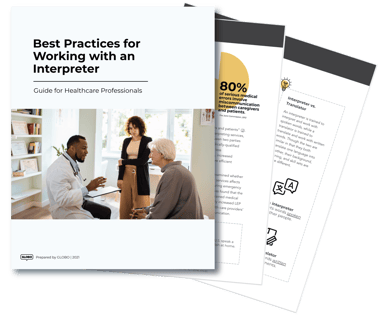Stay up to date.
Stay connected with tips, resources & stories on language access.
For working with interpreters in healthcare settings to be most effective, it helps for healthcare providers and staff to know the best practices for working with an interpreter.
Over 67 million people in the United States speak a language other than English at home. For the portion of that population who are not proficient in English, health disparities persist, often leading to higher rates of hospitalization and worsened health conditions due to miscommunication.
Interpreters available through language support services help ensure limited-English proficient (LEP) patients have access to quality care, as well as healthcare communications they can understand. Using our free guide, "Best Practices for Working with an Interpreter," you can equip your providers and staff with the knowledge needed to communicate more efficiently with multilingual patients.
In healthcare, patients need the reassurance that can come along with face-to-face interactions. While communication is occurring through the interpreter, keep in mind that the information you are relaying is directed toward the patient. Use first-person language (e.g., you, your, you're) and avoid precursory instructions like "ask the patient" or "tell her/him." Some points of communication are also non-verbal, such as facial expressions and gestures. Paying attention to these can help you better understand patient reactions and responses and vice versa.
Speak in short segments for easier interpretation. Additionally, speak slowly, so your words are easier to recall and understand. Avoid wordy, complex sentences or streams of communication as this can lead to important information being misheard or forgotten during interpretation.
The best language translation occurs when the interpreter has a clearly audible voice to follow. If you are using telephone or video interpretation, be aware of background noise that could interfere with audibility and the overall accuracy of the translation. Do your best to ensure LEP patients are treated and consulted in rooms where background noise will not be an issue.
Avoid overly technical speak. Instead, speak simple words, which are more likely to be easy for the interpreter to translate in a way that the patient understands. Avoid idioms, generalizations, or culturally centered speak that the LEP patient may not understand. For example, what could be understood as humor in English may not be the same in the patient's first language.
Once you speak, the interpreter will need time to structure what you say and deliver that information to the patient. Therefore, be sure to pause after speaking a sentence to allow time for interpretation. Also, avoid asking multiple questions or delivering multiple conjoined statements all at one time.
Some English concepts may not have a viable equivalent in other languages. If you have something you need to communicate that could lead to a cultural misunderstanding, the highest-quality interpreter will often let you know and help you frame the information in a more effective way. Be mindful of cultural competency practices, which are all about effective communication in spite of cultural differences.
When working with an interpreter, regardless of the interpretation mode being used, assume every word you speak will be interpreted. This is one reason why it is important that you are in an area where you can give your patient undivided attention. If you are speaking to other people during the appointment, everything you say may be translated for the patient.
Teach-back involves asking the LEP patient to relay the information you have provided them back to you. For example, if you provide instructions for wound care, have the patient relay those instructions back to you to show that they understood. This feedback loop can help you prevent misunderstandings.
Your goal with all patients should be to ensure they understand what you have communicated to them during their visit. With LEP patients, this process can take a little longer, so step into the encounter with patience and understanding.

While working with an interpreter can come as a new experience for some, getting familiar with the basics can do a lot for LEP patients who are at higher risk for inadequate care.
Download our free guide, Best Practices for Working with an Interpreter, to equip your providers and staff with the tools needed to communicate during interactions with LEP patients.